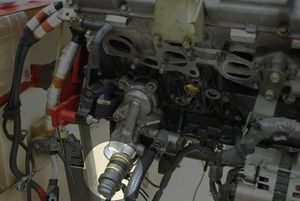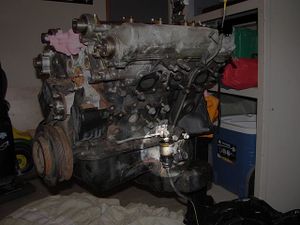Oil Pressure Sending Unit
The Oil Pressure Sending Unit (or OPSU) is a sensor that reads the oil pressure and sends it to the gauge cluster.

Contents
[hide]Function
As implied by the name, the OPSU is a simple sensor that returns a variable output resistance depending on the pressure exerted on it's internal diaphragm. It is used only for the oil pressure gauge, and is not monitored by the ECU or any other engine control components.
Location
The OPSU can be found in one of two locations: on the oil filter tree (left hand drive models) or the left side of the block (left turbo feed line on TT models) for right hand drive cars. The Oil Pressure Sending Unit uses a ⅛ BSPT, as do most aftermarket OPSUs (at least, those from Japanese manufacturers). NISMO once sold a T-Fitting to run two oil pressure sending units (ie, stock and aftermarket), which was basically a three-way female ended ⅛ BSPT T-Fitting with a male-male ⅛ BSPT adapter on the end. P/N 25073-RN010, this part is no longer available.
|
The OPSU location on a USDM (LHD) engine. Image from |
The OPSU location on a Japanese (RHD) engine. Image |
Failure
The OPSU is a common point of failure. It's feed hole is quite small and easily becomes clogged by contaminants in the oil, or thicker oil viscosity. It can be cleaned or replaced easily during any oil change by simply unscrewing it from it's mount. It does not require any thread locker for installation, as it receives its electrical ground through its threads.
When the OPSU fails, the oil pressure gauge will read little or no oil pressure. It is important to listen for any ticking (ie, lifter tick) or other strange noises to verify that the oil pressure isn't actually low. Running an engine with little or no oil pressure will lead to severe damage (and up to complete failure) of the engine. Because of its unreliability, many owners also install an aftermarket oil pressure gauge.
Oil Tree O-Ring
Some owners report replacing the OPSU multiple times and finding each unit reporting low oil pressure readings. While the OPSU is prone to failure, it usually lasts several years before giving up the ghost. This sort of chronic low oil pressure reading is usually either caused by either truly low oil pressure, or failure of an internal o-ring in the oil filter tree.
This O-ring is located inside the main oil gallery of the oil filter tree where the tree meets the block. It is quite easy to replace with the engine out, as removal of the oil tree only requires a few bolts to come out. However, with the engine in, it's practically impossible, if not just due to the difficulty in cleaning the paper gasket from the oil tree's mating surface.
It should be noted that when this O-ring fails, the oil pressure isn't actually low. It simply allows oil to bypass the oil filter (and OPSU) which, while not a good thing, certainly isn't as serious as a true low oil pressure condition.


